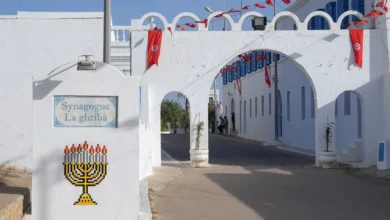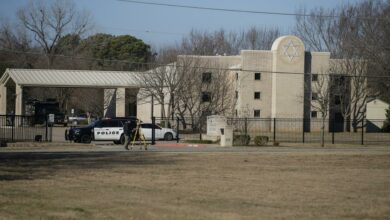The first sign says it’s a National Democratic Party (NDP) office. Another establishes it as a Ministry of Social Solidarity local unit. A third sign claims it belongs to "El Wayli Kindergarten." But really, the building is a synagogue, a Jewish house of worship.
Curious pictures of this Cairo temple were first posted by Egyptian blogger Mostafa Hussein last year. The photos, which showed a sign of the ruling NDP in front of the building’s main door and a handful of employees working inside, generated a buzz in the Egyptian online social networks like Twitter and Facebook.
The building, in the eastern Cairo neighborhood of Hadayeq el-Qubba, turned out the bygone synagogue that has been revived for different functions at different times. It consecutively became a public kindergarten, a local headquarters for the NDP, and a local administrative center for the Ministry of Social Solidarity. Signs remain from each of the three functions, suggesting a rather schizophrenic identity.
People living in the area recall the building being a synagogue until the 1960s, but aren’t entirely sure what has become of it since. "Our building used to be filled with Jews. But they all left. This synagogue used to function long time ago, but I don’t recall when it stopped. Now it has become related to the government," says Saleh Mahdy, a 72-year-old retired accountant who lives in the building adjacent to the synagogue.
Equally visually confusing is the presence of a small mosque which has almost cordoned the synagogue with its freshly painted green fence. A men’s prayer room stands to the right of the synagogue’s main body and a women’s prayer room is on the left. According to Mahdy, the mosque is only a handful of years old. “It looks ridiculous. I totally disagree with its presence there,” he says.
At night, the synagogue looks like nothing but a distant relic of the past with its huge dark gates and walls with Hebrew inscriptions, run-down stairs, and ancient wooden chairs covered with cobweb. An old woman was seated on the stairs of the synagogue. When asked about it, she said she knew nothing. "My husband used to work as an office boy in the kindergarten. When he died, the [Ministry of] Social Solidarity people gave me a room to stay here," she said, pointing to a small wooden structure behind the synagogue. She had extended a laundry rope from the synagogue’s wall to her small house where she hung her clothes.
During the day, the synagogue is the working space for about 30 employees who say they work for the Ministry of Social Solidarity.
But inside lies a grandiose structure that features a central cupola, Hebrew inscriptions, spiral stairs, huge marble columns and tiles, and ancient wooden gates and chairs. The original stained glass panes, in the shape of the star of David and other geometrical formations, are mostly intact. In the eastern side of the interior architecture–pointing towards Jerusalem–sits the holy ark, otherwise known as the hechal, a curtained niche where the Torah scrolls were kept. The niche is now covered by a makeshift curtain, but the scrolls are long gone. Instead, a bunch of old government folders are scattered behind the curtain.
Above the niche, an old Fatah poster of President Gamal Abdel Nasser fails to hide the faded but legible golden Hebrew letters, spelling "Gateway to the Righteous." Above those still are a pair of tablets, on which are inscribed the ten commandments. The "Eternal Light" that hangs above the niche, a common feature in all synagogues, has long been turned out.
In stark contrast to the historical feeling of the synagogue are wooden partitions that divide the space into quasi-offices. Employees sit behind grey metal desks reminiscent of a 1960s and 1970s office style. When Al-Masry Al-Youm paid the office a surprise visit, the employees were having their usual breakfast of fuul and taamiya.
"We’ve been here for the past 20 years. They keep telling us it’s a temporary location," said a female employee. "Didn’t they occupy Al-Aqsa mosque? We’re occupying them here," said another. Many complained that the synagogue is not the perfect working environment because it’s too cold in the winter and too hot in the summer.
"It’s so old that I feel there are ghosts hidden somewhere in the walls," said another woman.
Despite the seeming lack of local knowledge about the 400-square-meter synagogue, it does have a long history. It was built by an Egyptian Jewish family that resided in the neighborhood. “This temple was built by the Adda family,” says Carmen Weinstein, president of the Egyptian Jewish Community Council (JCC).
"The Adda’s were a Jewish Egyptian family of industrialists and bankers, who contributed to the growth of the Egyptian economy in the 1940s. I wish the state would preserve this temple, which is unique in this part of the city." For Jewish communities in Egypt before 1952 it was customary to erect neighborhood synagogues. "In each neighborhood, the local Jewish collectivity built a synagogue," says Weinstein, who also points out that while 29 synagogues once existed in Cairo, only 13 remain.
When contacted for more information about the building, Cairo Governorate officials expressed surprise with respect to the building’s unusual status, and gratitude that Al-Masry Al-Youm reporters brought the matter to their attention. According to one governorate employee who wanted to remain anonymous, the building is recognized in the district’s files, but has no licenses or ownership documents.
"This means that no measures of demolition, or restoration, have been taken with respect to the building. Nevertheless, the Hadayeq el-Qubba district headquarters believe the construction to be stable and safe," he says. "Since there has been no ownership documents for the synagogue, the government has put its hand on it."
Abdallah Attar of the Sector of Islamic and Coptic Monuments in the Supreme Council of Antiquities says that the synagogue is not considered a registered monument and therefore does not fall under the jurisdiction of the council. "The Permanent Monuments Committee has to agree to register it as a monument under Law 117/1983," he says. According to the law, the minister of culture or the prime minister has to approve the registration, based on the age of the monument and its architectural standards.
"Once registered, a monument of the Supreme Council of Antiquities becomes regulated by the law in terms of the organization of its use and the criminalization of any violations against it," Attar says. The synagogue of Hadayeq el-Qubba is not one of the registered synagogues as antiquities and therefore falls out of the Supreme Council’s jurisdiction, according to Attar. He says there are only nine registered synagogues in Egypt.
"It is not registered as an antiquity because we’re yet to formally request it," Weinstein explains. "But I have recently spoken to [head of the Supreme Council of Antiquities] Zahi Hawwas, and he requested we submit a report about it." Regarding the presence of government employees, Weinstein says that the JCC "submitted a request to the Ministry of Social Solidarity to have their offices relocated so that the synagogue can be returned to its original appearance and made into a touristic site." The ministry’s response? "They responded that they needed to find a new location first."
Hadayeq el-Qubba was once home to some of the wealthiest Egyptian families and local foreign minorities before the 1950s. The commercial Egypt and Sudan Avenue, for instance, was then known as the King of Egypt and the Sudan Avenue and led straight to the residence of King Farouk, royal Egypt’s last sovereign.
The Cairo Governorate official says that "it appeared that the place had no owner; which is why the state decided to take it over. A similar situation applies to many buildings in Cairo and elsewhere. The case of this building is extremely interesting; we’d be keen on searching further in the specifics of the case, and figure out whether it needs to be restored."
But Weinstein thinks differently. "A synagogue, just like a mosque or a church, belongs first and foremost to the community [of worshipers]. No one can say that a synagogue has no owner."




